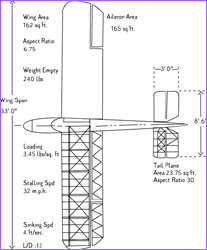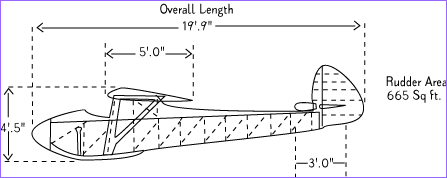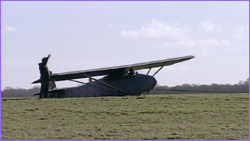 |
 |
|  Top-view plans for the Colditz glider, copied from the drawing made
at Colditz. Click on the
image to view a larger version.
Top-view plans for the Colditz glider, copied from the drawing made
at Colditz. Click on the
image to view a larger version.
|
The Colditz Glider
Building the Colditz Glider
On a snowy day in December, 1943, while he looked out over the German town of
Colditz, POW Bill Goldfinch noticed snowflakes outside his window drifting
upward. Perhaps it would be possible, he thought, to escape from the prison in
a glider. The updraft would help in getting the glider airborne. Also, there
was an ideal area from which to launch a glider: the castle's chapel roof,
which was hidden from the guards' watchful eyes. The prisoners could use ropes,
pulleys, and a counterweight to propel the glider along the roof.
Goldfinch presented his idea to Dick Howe, head of the prison's escape
committee, who approved it. Goldfinch's best friend, Jack Best, was also
assigned to the project.
Using a textbook discovered in the prison library, Goldfinch and Best, both
engineers, worked out the specifications for a glider. It would carry a pilot
and one passenger. The wings would have enough lift to carry the glider's occupants
over the town of Colditz—more than 300 feet below—and across the River
Mulde. Goldfinch then drew up the plans.
 Side-view plans for the Colditz glider.
Side-view plans for the Colditz glider.
|
Goldfinch and Best began building the glider in their rooms. This, of course,
could only be temporary since it would be impossible to hide such a large
project from the guards. So in one of the castle's attics—the one adjacent
to the roof slated for the runway—prisoners created a workshop. Using
shutters and mud made from attic dust, they constructed a false wall at one end
of the attic, giving the glider builders a small space that could accommodate
the largest of the disassembled glider pieces. When they were finished, anyone
who went into the main part of the attic saw a convincing false wall at one end
and no indication that the attic was eight feet shorter than before. To gain
access to the shop, the prisoners also built a trapdoor in the shop's
floor.
 A replica of the Colditz glider preparing for its initial
flight.
A replica of the Colditz glider preparing for its initial
flight.
|
|
The materials needed to fashion the tools and glider were for the most part
scavenged. The prisoners made a plane from a table knife, drills from nails,
saw handles from bed boards, and saw blades from both a wind-up record player's
spring and the frame around iron window bars.
For the glider's control wires they appropriated electrical wire taken
from unused areas of the castle. For the wings' spars (main supports) and ribs
they availed themselves of floorboards and bed slats, respectively. And to cover the glider's
wooden frame they used bed sheets, which they doped with hot millet (part of
their rations) to stiffen the fabric. They obtained a few items through
bribery: casein glue and a metal drill, for example.
Constructing the glider's parts was tedious, to say the least. For the wings
alone the builders had to craft over 6,000 hand-fashioned pieces. To make just
one rib, they had to shape a piece of wood, steam it to render it pliable, bend
and pin it, then finally glue it into place. And the glider required hundreds
of these.
|  The replica glider in flight.
The replica glider in flight.
|
Takeoff was finally scheduled for the spring of 1945. The plan was to assemble
the aircraft, then catapult it off the chapel's roof using a metal bathtub
filled with concrete as ballast. The tub would fall five stories. The glider
would then sail out silently over the town of Colditz, giving its occupants a
good head start over the German guards, who would soon discover a bathtub in
the yard and two prisoners missing.
But alas, the launch never took place. The war was nearing its end, and it was
decided to postpone what would have been the glider's brief and only
flight.
Escaping Colditz |
The Jailor's Story |
Great Escapes |
The Colditz Glider
Resources |
Transcript |
Site Map |
Nazi Prison Escape Home
Editor's Picks |
Previous Sites |
Join Us/E-mail |
TV/Web Schedule
About NOVA |
Teachers |
Site Map |
Shop |
Jobs |
Search |
To print
PBS Online |
NOVA Online |
WGBH
© | Updated January 2001
|
|
|